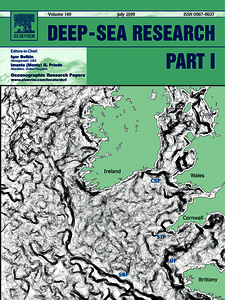Suberg, LA, Miller, PI and Wynn, RB 2019 On the use of satellite-derived frontal metrics in time series analyses of shelf-sea fronts, a study of the Celtic Sea. Deep Sea Research Part I: Oceanographic Research Papers. 10.1016/j.dsr.2019.04.011
Preview |
Text
LSuberg_et_al_DSR1_2017_198_revised_none.pdf - Accepted Version Available under License Creative Commons Attribution Non-commercial No Derivatives. Download (1MB) | Preview |
![suberg_cover_dsr1_jul2019.jpg [thumbnail of suberg_cover_dsr1_jul2019.jpg]](https://plymsea.ac.uk/8189/7.hassmallThumbnailVersion/suberg_cover_dsr1_jul2019.jpg)  Preview |
Image
suberg_cover_dsr1_jul2019.jpg - Published Version Available under License Creative Commons Attribution Non-commercial No Derivatives. Download (573kB) | Preview |
Abstract/Summary
Satellite-derived frontal metrics describe characteristics of oceanic thermal fronts, such as their strength or persistence. They are used in marine science to investigate spatio-temporal variability of thermal fronts or in ecological studies to assist in explaining animal distributions. Although these metrics represent highly processed data, which is based on sometimes complex algorithms, little guidance is available on their correct application in quantitative analyses, in particular for non-specialist users. This research aims to improve accurate use of frontal data. This case study investigates the inter--annual and seasonal variability of two tidal mixing fronts on the Celtic Sea shelf, based on monthly time series of daily frontal maps at ∼1km2 resolution from 1990 to 2010. Some metrics are almost identical and can be grouped, e.g. frontal probability, persistence and so-called “composites” (Pearson correlation: r = 0.8–1.0; p < 0.001), whereas the metric describing frontal strength is distinct from other ones. Consequently, strength and metrics of the frontal probability group showed pronounced differences in their inter-annual and seasonal variability: Strength displayed an oscillating pattern between 1990 and 2010 while there were no significant changes in probability over time. In addition, seasonal variability was affected by segments from adjacent fronts, not belonging to the fronts of interest, which could result in biased estimates. Most important, there was a doubling of available satellite imagery between 1990 and 2010 due to a greater number of operational satellites, which negatively affected frontal probability, positively frontal strength and consequently, changed the temporal pattern of both. When using frontal maps for temporal analyses, we should choose the metric carefully, be aware of biased estimates caused by variability from unwanted frontal segments in the data and account for the variable data quantity. This guide on the use of frontal metrics will be helpful to improve correct interpretations of statistical analyses.
| Item Type: | Publication - Article |
|---|---|
| Divisions: | Plymouth Marine Laboratory > National Capability categories > Added Value |
| Depositing User: | Kim Hockley |
| Date made live: | 09 May 2019 14:38 |
| Last Modified: | 25 Apr 2020 10:00 |
| URI: | https://plymsea.ac.uk/id/eprint/8189 |
Actions (login required)
 |
View Item |


 Tools
Tools Tools
Tools